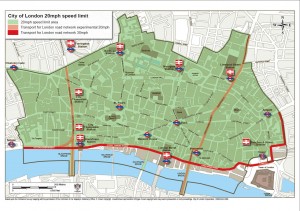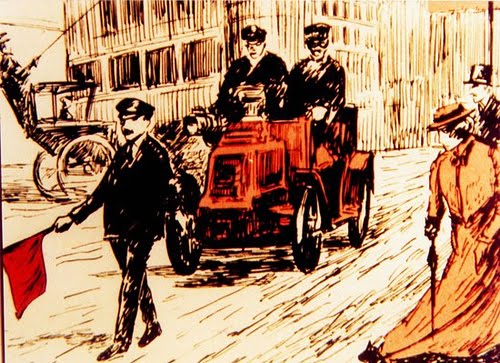On 20th July 2014, a blanket speed limit of 20mph was introduced in the City of London:
Why did they decide to do that? It was apparently part of their “Road Danger Reduction Plan“. And yet, reading that, it’s not speed that’s the issue with the highest at-risk groups of cyclists, pedestrians and motorcyclists.
Cyclists:
- “… 84% of casualties are involved in collisions at intersections or junctions. This is in line with the Greater London average.
- Collisions are more likely to occur in the middle of junctions rather than on their approaches.
- Failure to see a cyclist appears to be a significant causal factor.
- The main contributory factors identified in cyclist casualties are “turning rightâ€, “changing lanesâ€, “opening vehicle doors†and “undertaking of large vehicles turning left across cyclists pathâ€. The last factor being the most significant in KSI casualties.”
Uh-huh. So speed isn’t really at issue at all here and indeed it looks like the main issue is cyclists with a deathwish undertaking – no pun intended – large vehicles.
Motorcyclists and Scooterists:
“…As 72 per cent of motorcyclists were injured due to the actions of other road users, a significant reduction in motorcyclist casualties will only be achieved by addressing the behaviour of other road users, particularly car, taxi, and goods vehicle drivers and by increasing motorcyclists’ awareness of other road users. The most common causes of a motorcyclist being injured are pedestrian lack of attention, motor vehicles turning right across their path, and vehicles U turning.”
I see. So the trouble here is pedestrians and vehicles doing right and U turns, neither of which are speed-related.
Pedestrians:
“Goods vehicles, coaches and buses are disproportionately involved in collisions….
“Pedestrian inattention†has been identified as the main contributory factor for pedestrian casualties.”
Interestingly, it also notes that there are clusters of casualties around the stations where “the City experiences considerable over-crowding of footways, particularly at peak times, with pedestrians stepping onto the carriageway.” So it appears that people stepping off the overcrowded pavements into the path of slower-moving vehicles is the risk here, again rather than speeding. Perhaps investment/improvement into the pedestrian walkways is the key here?
According to the London Evening Standard:
Michael Welbank, speaking on behalf of City of London council, said: “For the City of London to continue its success as an international business hub it is critical that its streets should be safe for all who use them be they commuters, pedestrians, cyclists, drivers, motorcyclists, shoppers or cultural wanderers and dreamers.â€
So maybe infrastructure investment might be a better idea, along with enforcement of other legislation and education of pedestrians and cyclists? Or why not simply reintroduce the Locomotive Act 1875, although this would mean fewer speeding fines and less “Being Seen To Be Doing Something”:



You must be logged in to post a comment.